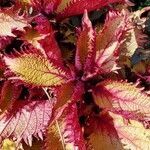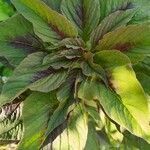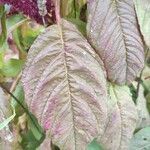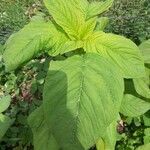Annual; stem under cultivation erect and often very robust, up to 1½-2½ m high, in a wild state usually much smaller, erect or ascending, angular, glabrous or in higher part thinly pubescent. Leaves (larger ones at least) long-petioled, rhomboid-ovate-oblong-lanceolate from a cuneate or acute, often decurrent base, narrowed in upper part, acute, obtuse, rounded, retuse or emarginate, glabrous or on larger nerves thinly pubescent, in wild specimens entirely green, in cultivated (for ornament) forms often tinged or blotched with purple or entirely purple, sometimes bright red with yellow; larger leaves 10-25 by 3-12 cm. Flower-clusters dense; lower ones axillary, higher ones often collected in rather thick spike; ♂ and ♀ flowers intermixed; bracts and bracteoles long-awned from broad base, as long as adult perianth or shorter. Tepals 3, long-awned from broad base, with broad transparent margins and green or purple median band, in ♀ 3½-6 mm long, in ♀ at first 2-3 mm, under the ripe fruit 3-5 mm. Filaments about as long as perianth or shorter, often much shorter; ovary cylindrical or obconical; styles 3, 2-2½ mm long. Utricle flask-shaped, circumsciss somewhat below middle; lid with thickened base and suddenly contracted, conical, obtuse apex. Seed with a rather obtuse margin, shining blackish brown or brown, 1-1 ¼ mm diam.
Plants annual, glabrous. Stems erect, often branched, 0.8-1.5 m. Leaves: petiole 1/2 as long as blade; blade ovate, elliptic, rhombic, or lanceolate, mostly 4-12 × 1.4-6 cm, base tapering, margins entire, usually undulate, apex acuminate and short-mucronate; distal leaf blades green, red, scarlet, maroon, purple, yellow, and cream (unique to A. tricolor). Inflorescences axillary glomerules. Bracts of pistillate flowers ovate to lanceolate, 5-6 mm. Pistillate flowers: tepals 3, narrowly ovate to lanceolate, 5-6 mm, apex aristate; style branches spreading; stigmas 2-3. Staminate flowers intermixed with pistillate; tepals 3; stamens 3. Utricles ovoid, 2-2.5 mm, rugose, dehiscence regularly circumscissile. Seeds black or brownish black, subglobose, 1 mm diam., shiny.
A herb about 1 m high and spreads 45 cm wide. A small annual leafy green. An upright, much branched annual with a thin membrane covering the stems. Sometimes the plant lies over. The stems are angular. The plant branches in the upper part of the plant. It is smooth and grows from seed each year. Leaves have long leaf stalks which can be 5-10 cm long. Leaves vary in shape, size and colour. The leaf blade can be 5-25 cm long by 2-6 cm wide. Leaves are dull purplish and the top leaves can be yellow or red. Some types have coloured leaves or patterns on the leaves. It has a clumpy seed head at the top. The flower spike at the top can be 30 cm long. The seed are 1-1.2 mm across and black.
Stem green or red, 80-150 cm tall, stout, often branched. Petiole green or red, 2-6 cm; leaf blade green, red, purple, or yellow, ovate, ovate-rhombic, or lanceolate, 4-10 × 2-7 cm, glabrous, base cuneate, margin entire or undulate, apex obtuse or notched, with a mucro. Flowers in dense clusters at leaf axils or in spike at apex; male and female flowers in same inflorescences. Bracts and bracteoles ovate-lanceolate, 2.5-3 mm, transparent, apex long pointed. Stamens 3. Stigmas 3. Utricles included in perianth, ovate-oblong, 2-2.5 mm, circumscissile. Seeds brownish black, subglobose or obovoid, ca. 1 mm in diam. Fl. May-Aug, fr. Jul-Sep. 2n = 34*, 68, 85*.
Leaves glabrous, or thinly pilose on the inferior surface of the primary venation, green or purplish-suffused, long-petiolate (petioles to c. 8 cm. long), the lamina broadly ovate, rhomboid-ovate or broadly elliptic to lanceolate-oblong, acute to obtuse or emarginate at the apex, shortly cuneate to attenuate at the base.
Bracts and bracteoles broadly or deltoid-ovate; bracteoles subequalling or shorter than the perianth, pale-membranous, broadest near the base and narrowed upwards to the green midrib, which is excurrent to form a long, pale-tipped awn which is usually at least half as long as the basal part and not rarely equalling it.
Flowers green to crimson, in more or less globose clusters c. 4–25 mm. in diam., all or only the lower axillary and more or less distant, the upper sometimes without subtending leaves and increasingly approximate to form a thick terminal spike of variable length; male and female flowers intermixed.
Perianth segments 3, 3–5 mm. long, elliptic or elliptic-oblong, narrowed above, pale-membranous, the green midrib excurrent into a long, pale-tipped awn; segments of the female flowers slightly accrescent in fruit.
Stem stout and usually branched, both it and the branches angular, glabrous or furnished in the upper parts with sparse (or denser in the inflorescence), more or less crisped hairs.
Capsule ovoid-urceolate with a short beak below the style-bases, 2.25–2.75 mm., membranous, obscurely wrinkled, circumcissile.
Annual herb, ascending or erect, attaining c. 1.25 m. in cultivation in Africa (taller in Asia).
Seeds 1–1.5 mm. wide, black or brown, shining, faintly reticulate.
Erect herb, 2–6 ft. high; leaves, stems and flowers green or red
Stigmas 3, erect or recurved, c. 2 mm. long.
A cultivated spinach.




